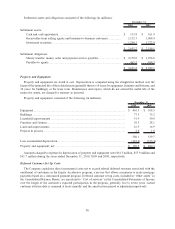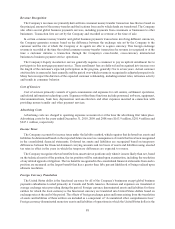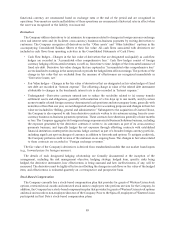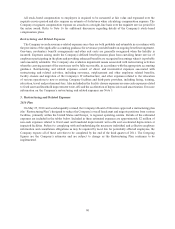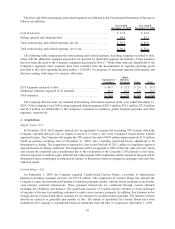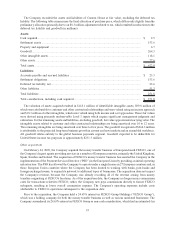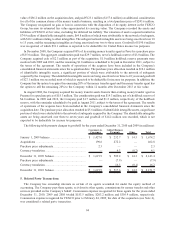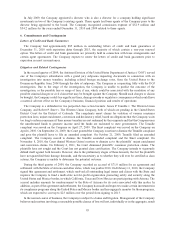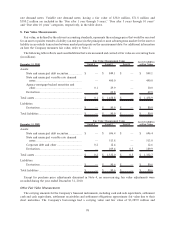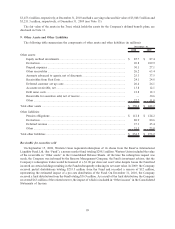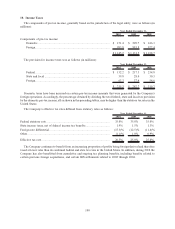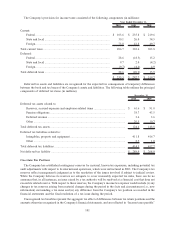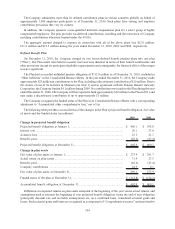Western Union 2010 Annual Report Download - page 98
Download and view the complete annual report
Please find page 98 of the 2010 Western Union annual report below. You can navigate through the pages in the report by either clicking on the pages listed below, or by using the keyword search tool below to find specific information within the annual report.in a material adverse effect on the Company’s financial position, results of operations and cash flows. The Company
accrues for loss contingencies as they become probable and estimable.
In May 2007, the Company initiated litigation against MoneyGram Payment Systems, Inc. (“MoneyGram”) for
infringement of the Company’s Money Transfer by Phone patents by MoneyGram’s FormFree service. On
September 24, 2009, a jury found that MoneyGram was liable for patent infringement and awarded the
Company $16.5 million in damages. On December 7, 2010, the United States Court of Appeals for the Federal
Circuit reversed the trial court’s judgment. On January 6, 2011, the Company filed a Combined Petition for Panel
Rehearing and Rehearing En Banc in the Federal Circuit, which was denied on February 8, 2011. In accordance with
its policies, the Company does not recognize gain contingencies in earnings until realization and collectability are
assured.
Pursuant to the separation and distribution agreement with First Data in connection with the Spin-off, First Data
and the Company are each liable for, and agreed to perform, all liabilities with respect to their respective businesses.
In addition, the separation and distribution agreement also provides for cross-indemnities principally designed to
place financial responsibility for the obligations and liabilities of the Company’s business with the Company and
financial responsibility for the obligations and liabilities of First Data’s retained businesses with First Data. The
Company also entered into a tax allocation agreement that sets forth the rights and obligations of First Data and the
Company with respect to taxes imposed on their respective businesses both prior to and after the Spin-off as well as
potential tax obligations for which the Company may be liable in conjunction with the Spin-off (see Note 10).
7. Investment Securities
Investment securities, classified within “Settlement assets” in the Consolidated Balance Sheets, consist
primarily of high-quality state and municipal debt securities. The Company is required to maintain specific
high-quality, investment grade securities and such investments are restricted to satisfy outstanding settlement
obligations in accordance with applicable state and foreign country requirements. The substantial majority of the
Company’s investment securities are classified as available-for-sale and recorded at fair value. Investment securities
are exposed to market risk due to changes in interest rates and credit risk. The Company regularly monitors credit
risk and attempts to mitigate its exposure by making high-quality investments and through investment
diversification. At December 31, 2010, the majority of the Company’s investment securities had credit ratings
of “AA-” or better from a major credit rating agency.
On October 1, 2009 (the “Transition Date”), the Company assumed IPS’s role as issuer of money orders and
terminated the existing agreement whereby IPS paid the Company a fixed return of 5.5% on the outstanding money
order balances. Following the Transition Date, the Company invested the cash received from IPS in high-quality,
investment grade securities, primarily tax exempt United States state and municipal debt securities, in accordance
with applicable regulations. Prior to the Transition Date, the Company had entered into interest rate swaps on
certain of its fixed rate notes to reduce its exposure to fluctuations in interest rates. Through a combination of the
revenue generated from these investment securities and the anticipated interest expense savings resulting from the
interest rate swaps, the Company estimates that it should be able to retain a materially comparable after-tax rate of
return through 2011 as it was receiving under its agreement with IPS. Refer to Note 14 for additional information on
the interest rate swaps.
Subsequent to the Transition Date, all revenue generated from the investment portfolio is being retained by the
Company. IPS continues to provide the Company with clearing services necessary for payment of the money orders
in exchange for the payment by the Company to IPS of a per-item processing fee. The Company no longer provides
to IPS the services required under the original money order agreement or receives from IPS the fee for such services.
In 2008, the Company began increasing its investment levels in various state and municipal variable rate demand
note securities which can be put (sold at par) typically on a daily basis with settlement periods ranging from the
same day to one week, but that have varying maturities through 2042. Generally, these securities are used by the
Company for short-term liquidity needs and are held for short periods of time, typically less than 30 days. As a
result, this has increased the frequency of purchases and proceeds received by the Company.
96


